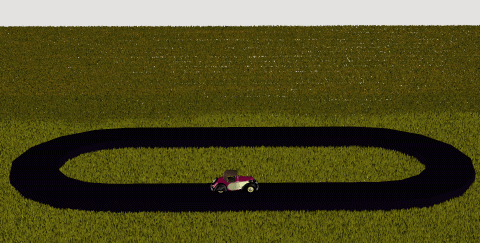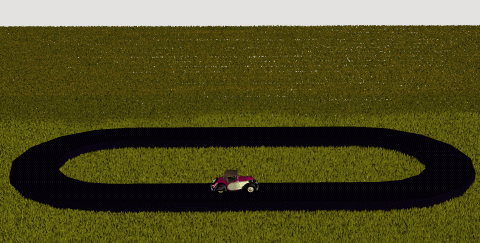Sunday, July 21, 2019
Science advances on materials, not ideas.
Toward the end of his 1641 book on codes and ciphers (p 168 in the PDF), Wilkins discusses communication systems that are magical or mythical. He debunks a system described in 1619 by Famiano Strada (p 404 in the PDF). Famiano described an ancient use of magnets to communicate at a distance without interception by enemies. Turn one compass needle and the other moves in sympathy. Wilkins points out correctly (at the time) that this only works for a distance of two or three feet, so he concludes that Famiano was describing a myth instead of a practical method.
Needles to say, we still use this ancient system, and it works over thousands of miles, even to the moon and back.
What changed? We figured out how to wiggle the sending magnet really really fast, using electromagnets to form the field. Fast wiggles transfer more energy. You don't need quantum quackery to feel this concept. Just move your hand up and down slowly, then move it up and down fast. You have to transfer more energy into the muscles to move it fast, even though the distance of each wiggle is the same.
For a more visible example, imagine the car is a magnet vibrating back and forth, switching poles at each corner. Fast and slow are covering the same distance in each lap. Fast uses more energy (gas), and fast transfers more energy (damage) when the car hits something.

 = = = = =
Two critical improvements had to precede the development of radio. The first one came just after Wilkins. Around 1680 the manufacture of small-gauge wire became commercially practical. The next one was the storage battery in 1800, which provided a steady source of moving electrons through the wire. After those two developments invention zoomed forward, with commercial telegraphy in 1830 and wireless around 1880.
Wilkins was using rigorous scientific thinking, trusting experiments over theory. He recognized that wireless communication was possible, but had no way to visualize the improvement resulting from thousands or millions of wiggles per second.
Again needles to say, Nature got there first with radio fish, but we didn't recognize what Nature had done until we built sufficiently sensitive receivers.
All inventions are either long-standing dreams or copies of Nature. Inventions happen when materials and manufacturing have advanced to the point where the old or natural dream can be implemented. There is EXACTLY ONE EXCEPTION to this rule, the phonograph. Before Edison got there accidentally, nobody had dreamed of recording sound, nobody had tried to record sound and Nature doesn't record sound. Our brains certainly record long sequences of language and music, but we record symbols and tokens, not sound waves. I can guess that birds function the same way, because they like to jazz up a sequence when replaying.
Searchable sidenote: It's a safe bet that no other text block includes "Famiano Strada" AND "fast wiggles" AND "radio fish" AND "jazz up".
= = = = =
Two critical improvements had to precede the development of radio. The first one came just after Wilkins. Around 1680 the manufacture of small-gauge wire became commercially practical. The next one was the storage battery in 1800, which provided a steady source of moving electrons through the wire. After those two developments invention zoomed forward, with commercial telegraphy in 1830 and wireless around 1880.
Wilkins was using rigorous scientific thinking, trusting experiments over theory. He recognized that wireless communication was possible, but had no way to visualize the improvement resulting from thousands or millions of wiggles per second.
Again needles to say, Nature got there first with radio fish, but we didn't recognize what Nature had done until we built sufficiently sensitive receivers.
All inventions are either long-standing dreams or copies of Nature. Inventions happen when materials and manufacturing have advanced to the point where the old or natural dream can be implemented. There is EXACTLY ONE EXCEPTION to this rule, the phonograph. Before Edison got there accidentally, nobody had dreamed of recording sound, nobody had tried to record sound and Nature doesn't record sound. Our brains certainly record long sequences of language and music, but we record symbols and tokens, not sound waves. I can guess that birds function the same way, because they like to jazz up a sequence when replaying.
Searchable sidenote: It's a safe bet that no other text block includes "Famiano Strada" AND "fast wiggles" AND "radio fish" AND "jazz up".

 = = = = =
Two critical improvements had to precede the development of radio. The first one came just after Wilkins. Around 1680 the manufacture of small-gauge wire became commercially practical. The next one was the storage battery in 1800, which provided a steady source of moving electrons through the wire. After those two developments invention zoomed forward, with commercial telegraphy in 1830 and wireless around 1880.
Wilkins was using rigorous scientific thinking, trusting experiments over theory. He recognized that wireless communication was possible, but had no way to visualize the improvement resulting from thousands or millions of wiggles per second.
Again needles to say, Nature got there first with radio fish, but we didn't recognize what Nature had done until we built sufficiently sensitive receivers.
All inventions are either long-standing dreams or copies of Nature. Inventions happen when materials and manufacturing have advanced to the point where the old or natural dream can be implemented. There is EXACTLY ONE EXCEPTION to this rule, the phonograph. Before Edison got there accidentally, nobody had dreamed of recording sound, nobody had tried to record sound and Nature doesn't record sound. Our brains certainly record long sequences of language and music, but we record symbols and tokens, not sound waves. I can guess that birds function the same way, because they like to jazz up a sequence when replaying.
Searchable sidenote: It's a safe bet that no other text block includes "Famiano Strada" AND "fast wiggles" AND "radio fish" AND "jazz up".
= = = = =
Two critical improvements had to precede the development of radio. The first one came just after Wilkins. Around 1680 the manufacture of small-gauge wire became commercially practical. The next one was the storage battery in 1800, which provided a steady source of moving electrons through the wire. After those two developments invention zoomed forward, with commercial telegraphy in 1830 and wireless around 1880.
Wilkins was using rigorous scientific thinking, trusting experiments over theory. He recognized that wireless communication was possible, but had no way to visualize the improvement resulting from thousands or millions of wiggles per second.
Again needles to say, Nature got there first with radio fish, but we didn't recognize what Nature had done until we built sufficiently sensitive receivers.
All inventions are either long-standing dreams or copies of Nature. Inventions happen when materials and manufacturing have advanced to the point where the old or natural dream can be implemented. There is EXACTLY ONE EXCEPTION to this rule, the phonograph. Before Edison got there accidentally, nobody had dreamed of recording sound, nobody had tried to record sound and Nature doesn't record sound. Our brains certainly record long sequences of language and music, but we record symbols and tokens, not sound waves. I can guess that birds function the same way, because they like to jazz up a sequence when replaying.
Searchable sidenote: It's a safe bet that no other text block includes "Famiano Strada" AND "fast wiggles" AND "radio fish" AND "jazz up".Labels: Carver, Grand Blueprint, storage
